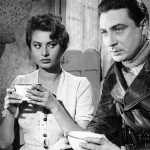 Food
Food  Food
Food  History
History 10 Odd Things Colonial Americans Kept at Home
 Weird Stuff
Weird Stuff 10 Superstitious Beliefs That Once Consumed Entire Cultures
 History
History 10 Bizarre Friendly Fire Incidents in Military History
 Technology
Technology 10 Modern Technologies That Accidentally Imitate Ancient Magic
 Mysteries
Mysteries 10 Mysteries of the Human Genome
 Weird Stuff
Weird Stuff 10 Things So Rare They’ve Only Been Found Once
 History
History 10 Legends Whose Last Moments Undid Their Glory
 Health
Health 10 Futuristic Ideas to Treat Common Medical Problems
 Weird Stuff
Weird Stuff Ten Surreal Attempts to Reverse Baldness
 Food
Food 10 Everyday Foods You Didn’t Know Were Invented by the U.S. Military
 History
History 10 Odd Things Colonial Americans Kept at Home
 Weird Stuff
Weird Stuff 10 Superstitious Beliefs That Once Consumed Entire Cultures
Who's Behind Listverse?

Jamie Frater
Head Editor
Jamie founded Listverse due to an insatiable desire to share fascinating, obscure, and bizarre facts. He has been a guest speaker on numerous national radio and television stations and is a five time published author.
More About Us History
History 10 Bizarre Friendly Fire Incidents in Military History
 Technology
Technology 10 Modern Technologies That Accidentally Imitate Ancient Magic
 Mysteries
Mysteries 10 Mysteries of the Human Genome
 Weird Stuff
Weird Stuff 10 Things So Rare They’ve Only Been Found Once
 History
History 10 Legends Whose Last Moments Undid Their Glory
 Health
Health 10 Futuristic Ideas to Treat Common Medical Problems
 Weird Stuff
Weird Stuff Ten Surreal Attempts to Reverse Baldness
Top 10 Greatest Things Terrible People Did
We’re only human. Sometimes, we make mistakes; sometimes, we do it right. Historical figures and celebrities are no different from us—they’ve done bad (and some have done A LOT of bad). However, sometimes, these figures, usually viewed as evil, have done a good thing that we never really hear about.
Here are some good things awful people did throughout history.
Related: 10 Wives of Dictators Who Met Unfortunate Ends
10 Ted Bundy
In 1971, Ted Bundy was a regular student at the University of Washington. He studied, cooked, and, like many college students, had a job. It just so happens this job was at the Seattle Suicide Hotline Center.
That’s right! Notorious serial killer Bundy spent his college years encouraging people not to end their lives. Former cop and author Ann Rule said at the time of his arrest that Bundy “took lives, but also saved lives.”
While it might seem crazy that a murderer would spend his time basically doing the opposite of killing people, it does sort of make sense. Clinical and forensic psychologist Darrel Turner believes the job might have actually made Bundy a more skilled killer. It gave him insight into the kinds of things vulnerable people need to hear to be persuaded to make such a major decision. “As someone who made a life study of manipulating other people, I think that it makes sense that he would get a job like that,” Turner said.[1]
9 Ivan the Terrible
To get stuck with “the terrible” as your moniker, you’ve got to be pretty bad. And Ivan the Terrible was. From executing civilians in order to gain land to murdering his own son, Ivan has not gone down well in history. But from a government perspective, he actually wasn’t so horrible. He created the Russian version of parliament, reformed church practices, and significantly expanded Russian lands.
As the first tsar of Russia, Ivan significantly expanded the Russian state during his reign from 1547 to 1584. He initiated a series of military campaigns, most notably against the Khanates of Kazan, Astrakhan, and Siberia, which were remnants of the Mongol Empire. By conquering these regions, he extended Russia’s territory eastward and southward, gaining control over the Volga River and opening up access to the Caspian Sea. Ivan’s expansion efforts also included attempts to establish a foothold in the Baltic region, though his efforts were largely unsuccessful against the Livonian Order and other European powers.
Though the word “terrible” at the time meant “fearsome” or “formidable,” not necessarily “bad,” the nickname has certainly stuck in a way Ivan probably wouldn’t love.[2]
8 Andrew Jackson
President Andrew Jackson is infamous in American history for leading the Trail of Tears, which, between 1830 and 1850, displaced 60,000 Native Americans from their ancestral homes and forced them in a cruel march across the country. In addition to this, Jackson’s rough personality and habit of nominating his friends to cabinet positions they were unqualified for has earned him a spot on many lists of the worst U.S. presidents.
Despite all this, Jackson did have one huge upside. He paid off the national debt for the first and only time in American history. Of course, then the economy tanked thanks to Jackson’s opposition to a central bank. Interestingly, on the side of the good, Jackson did adopt a young Native American child and raised him as his own after his mother was killed in a village raid during the Creek War. On the other hand, the Creek War was perpetuated by Jackson.
Some historians say it’s likely Jackson only adopted the child in an attempt to earn sympathy from the local Native Americans and not out of the goodness of his heart.[3]
7 Napoleon
Napoleon Bonaparte is mostly known for his attempts to take over Europe (maybe even the world). Under his rule, it is estimated that 1.3 million French civilians died during his military campaigns throughout the late 1790s and into the 1810s.
These gigantic numbers overshadow some of the good that happened during Napoleon’s rule, most notably the Napoleonic Codes. These allowed for more equality within French law and were a stepping stone toward abolishing the brutal feudal system which had crippled lower-class French people for centuries.[4]
6 Jim Jones
Until the 9/11 attacks, the Jonestown murder-suicide was the greatest single loss of American civil life in a deliberate attack. On November 18, 1978, Jim Jones forced 918 of his followers, including women and children, to kill themselves rather than be sent back home to America. The citizens of Jonestown had followed Jones to Guyana because they believed in his vision for a better future, one where everyone was equal regardless of race or class.
Indeed, Jones’s beliefs were quite liberal for the time. In the midst of the civil rights movement, Jones preached to an integrated congregation that God loved everyone and that we should treat others with kindness. Jones’s churches across America started as positive influences in the community, encouraging black and white people to interact and learn more about each other.
Over the years, Jones became addicted to drugs, which increased his incessant paranoia. Fearing that the U.S. government was out to get him, he took his followers to a remote rainforest in Guyana. There, he claimed they would create their own utopia. Despite the tragic ending to this story, it is interesting to note that the foundation of Jones’s beliefs was so admirable.[5]
5 Pablo Escobar
The King of Cocaine himself had a soft side, apparently. Pablo Escobar, the founder of the drug crime organization that would eventually become the Colombian cartel, was known among locals as Robin Hood.
Just as the mythical English adventurer stole from the rich and gave to the poor, Escobar used some of his massive wealth to help out his fellow man. From sponsoring local soccer teams to building hospitals and housing, Escobar’s reputation among Colombian locals was much more positive than it was with officials. So much so that he was actually elected to Colombia’s Congress in 1982![6]
4 Yakuza
The Yakuza is essentially the Japanese version of the mafia. They’re generally characterized by large tattoos and are so feared in Japan that some people with non-gang-related tattoos still experience discrimination due to the association.
However, when a devastating earthquake hit Japan in 2011, the Yakuza sprung into action in a positive way. They sent over 25 trucks with supplies such as diapers, food, flashlights, and water across the country to the areas that had been hit the hardest. One anonymous member of the Yakuza said: “There are no Yakuza or katagi (ordinary citizens) or gaijin (foreigners) in Japan right now. We are all Japanese. We all need to help each other.”[7]
3 Saddam Hussein
As a rule, dictators aren’t well-liked. Despite this Iraqi politician’s best efforts, Saddam Hussein follows this generality. He has gone down in history as a brutal and cruel leader.
Surprisingly, though, he actually did some good during his time in charge. Hussein implemented infrastructure across the country that built roads, promoted mining, and developed nearly all industries in Iraq. Formerly, most of Iraq lived without electricity, but under Hussein’s rule, this number shrunk. He established compulsory schooling as well, and illiteracy rates fell rapidly.
Even more unexpected is that women saw a huge increase in quality of life. The 1970s gave Iraqi women equal rights in marriage, divorce, inheritance, and custody, as well as the workforce.[8]
2 Al Capone
Even though Chicago isn’t called the Windy City due to its weather, it sure can get pretty dang cold there. Now imagine braving that freezing weather in the midst of the Great Depression with no food or shelter. Not a fun time to be in the Second City.
However, in 1930, Chicago’s most infamous resident took it upon himself to help his fellow citizens. Gangster Al Capone, best known for his involvement in the brutal St. Valentine’s Day Massacre, opened up a soup kitchen downtown. A Capone associate told a local newspaper he couldn’t stand to see the people starving, and nobody else seemed to be doing much, so the big boy decided to do it himself.
Thousands were given a hot meal, with no limits on second or third helpings. Unlike other assistance programs run by the government, Capone’s kitchen didn’t require any paperwork to prove need, and no questions were asked (in true mobster style.) One writer accurately described Capone as “an ambidextrous giant who kills with one hand and feeds with the other.” Even though Capone had no problem killing rival gang members, he couldn’t stand to watch civilians suffer.[9]
1 Hitler
Perhaps the most infamous man in history, Adolf Hitler’s love of animals is well-documented. Aside from his vocal love for his dog, Blondi (a German Shepard, of course), the German dictator was also a vegetarian.
Under his rule, Hitler and his fellow Nazis passed the Animal Protection Act in 1933, which criminalized the mistreatment or abuse of animals. This included those in circuses and zoos, something that was revolutionary for the time. Unpopularly, the Third Reich also implemented anti-hunting laws in order to protect wild animals.
Historian Matthew Piper believes that these laws regarding animals give us an interesting look into the Nazi party, as they bear a similar resemblance to the Nuremberg laws, which stripped Jews of German nationality. “The Nazis saw the land and the animals living on it as sacred to Germany, but they saw the ethnic minorities as invaders in their country,” he points out.
Rather than seeing these laws as a result of Hitler’s love for animals, it may be more related to Hitler’s German purism. He saw these animals as natural parts of the country, part of what made it so sacred, so they needed to be protected in order to preserve German heritage and culture.[10]








